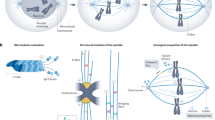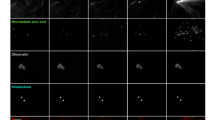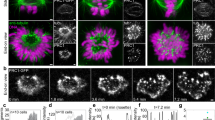Abstract
Cells have developed diverse ways to separate two microtubule asters to form a mitotic spindle. Here, I focus on two mechanisms used to position asters around chromosomes during mitosis: first, aster migration around the nuclear envelope and, second, aster attachment to a contractile cortex at the plasma membrane after the nuclear envelope has broken down. Although certain cell types use one mechanism predominantly, most rely on both to ensure proper spindle assembly.
This is a preview of subscription content, access via your institution
Access options
Subscribe to this journal
Receive 12 print issues and online access
$209.00 per year
only $17.42 per issue
Buy this article
- Purchase on Springer Link
- Instant access to full article PDF
Prices may be subject to local taxes which are calculated during checkout


Similar content being viewed by others
References
Hyman, A.A. & White, J.G. J. Cell Biol. 105, 2123–2135 (1987).
Rieder, C.L. & Khodjakov, A. Science 300, 91–96 (2003).
Theurkauf, W.E. & Hawley, R.S. J. Cell Biol. 116, 1167–1180 (1992).
de Saint Phalle, B. & Sullivan, W. J. Cell Biol. 141, 1383–1391 (1998).
Wadsworth, P. & Khodjakov, A. Trends Cell Biol. 14, 413–419 (2004).
Karsenti, E. & Vernos, I. Science 294, 543–547 (2001).
Heald, R. & Walczak, C.E. Curr. Opin. Struct. Biol. 9, 268–274 (1999).
Nedelec, F., Surrey, T. & Karsenti, E. Curr. Opin. Cell Biol. 15, 118–124 (2003).
Rattner, J.B. & Berns, M.W. Chromosoma 54, 387–395 (1976).
Lee, K.K., Gruenbaum, Y., Spann, P., Liu, J. & Wilson, K.L. Mol. Biol. Cell 11, 3089–3099 (2000).
Ueda, M., Schliwa, M. & Euteneuer, U. Mol. Biol. Cell 10, 151–160 (1999).
Busson, S., Dujardin, D., Moreau, A., Dompierre, J. & De Mey, J.R. Curr. Biol. 8, 541–544 (1998).
Robinson, J.T., Wojcik, E.J., Sanders, M.A., McGrail, M. & Hays, T.S. J. Cell Biol. 146, 597–608 (1999).
Vaisberg, E.A., Koonce, M.P. & McIntosh, J.R. J. Cell Biol. 123, 849–858 (1993).
Malone, C.J. et al. Cell 115, 825–836 (2003).
Sharp, D.J., Rogers, G.C. & Scholey, J.M. Nature 407, 41–47 (2000).
Holaska, J.M., Kowalski, A.K. & Wilson, K.L. PLoS Biol. 2, E231 (2004).
Rosenblatt, J., Cramer, L.P., Baum, B. & McGee, K.M. Cell 117, 361–372 (2004).
Enos, A.P. & Morris, N.R. Cell 60, 1019–1027 (1990).
Hagan, I. & Yanagida, M. Nature 347, 563–566 (1990).
Heck, M.M. et al. J. Cell Biol. 123, 665–679 (1993).
Kapoor, T.M., Mayer, T.U., Coughlin, M.L. & Mitchison, T.J. J. Cell Biol. 150, 975–988 (2000).
Goshima, G. & Vale, R.D. J. Cell Biol. 162, 1003–1016 (2003).
Sawin, K.E., LeGuellec, K., Philippe, M. & Mitchison, T.J. Nature 359, 540–543 (1992).
Bray, D. & White, J.G. Science 239, 883–888 (1988).
Canman, J.C. & Bement, W.M. J. Cell Sci. 110 (Pt 16), 1907–1917 (1997).
Wolpert, L. in International Review of Cytology Vol. 10 (eds Bourne, G. H. & Danielli, D. F.) 163–216 (Academic, New York, 1960).
Schroeder, T.E. Exp. Cell Res. 134, 231–240 (1981).
Khodjakov, A., Copenagle, L., Gordon, M.B., Compton, D.A. & Kapoor, T.M. J. Cell Biol. 160, 671–683 (2003).
Dasso, M. Cell 104, 321–324 (2001).
Kalab, P., Weis, K. & Heald, R. Science 295, 2452–2456 (2002).
Moore, W., Zhang, C. & Clarke, P.R. Curr. Biol. 12, 1442–1447 (2002).
Tulu, U.S., Rusan, N.M. & Wadsworth, P. Curr. Biol. 13, 1894–1899 (2003).
Lampson, M.A., Renduchitala, K., Khodjakov, A. & Kapoor, T.M. Nature Cell Biol. 6, 232–237 (2004).
Giet, R. & Prigent, C. Exp. Cell Res. 258, 145–151 (2000).
Acknowledgements
I would like to thank L. Cramer, R. Heald, A. Jaffe, A. Lloyd, M. Raff and M. Redd for critically reviewing this manuscript and for helpful discussions about mechanisms. I also thank B. Fasulo and B. Sullivan for contributing pictures of mitosis. Finally, I thank the scientists that have contributed to our understanding of spindle assembly and apologize to those whose work I have had to omit owing to space limitations. My work is supported by Cancer Research UK and BBSRC project grants.
Author information
Authors and Affiliations
Rights and permissions
About this article
Cite this article
Rosenblatt, J. Spindle assembly: asters part their separate ways. Nat Cell Biol 7, 219–222 (2005). https://doi.org/10.1038/ncb0305-219
Issue Date:
DOI: https://doi.org/10.1038/ncb0305-219
This article is cited by
-
Triple A patient cells suffering from mitotic defects fail to localize PGRMC1 to mitotic kinetochore fibers
Cell Division (2018)
-
Lateral attachment of kinetochores to microtubules is enriched in prometaphase rosette and facilitates chromosome alignment and bi-orientation establishment
Scientific Reports (2018)
-
Transient defects of mitotic spindle geometry and chromosome segregation errors
Cell Division (2012)
-
Differential control of Eg5-dependent centrosome separation by Plk1 and Cdk1
The EMBO Journal (2011)
-
Nek9 is a Plk1-activated kinase that controls early centrosome separation through Nek6/7 and Eg5
The EMBO Journal (2011)



